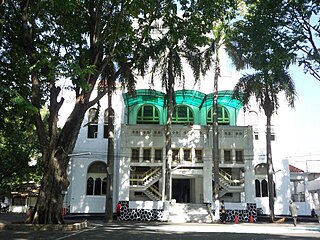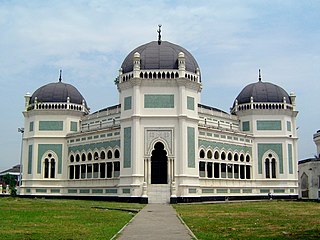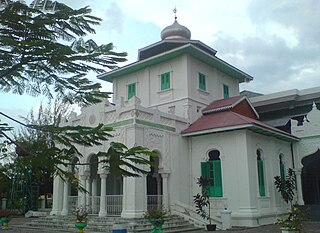A mosque, also called a masjid, is a place of worship for Muslims. The term usually refers to a covered building, but can be any place where Islamic prayers are performed, such as an outdoor courtyard.

Islamic architecture comprises the architectural styles of buildings associated with Islam. It encompasses both secular and religious styles from the early history of Islam to the present day. The Islamic world encompasses a wide geographic area historically ranging from western Africa and Europe to eastern Asia. Certain commonalities are shared by Islamic architectural styles across all these regions, but over time different regions developed their own styles according to local materials and techniques, local dynasties and patrons, different regional centers of artistic production, and sometimes different religious affiliations.

Istiqlal Mosque in Jakarta, Indonesia is the largest mosque in Southeast Asia and the ninth largest mosque in the world in terms of worshipper capacity. Built to commemorate Indonesian independence, this national mosque of Indonesia was named "Istiqlal", an Arabic word for "independence". The mosque was opened to the public on 22 February 1978. Within Jakarta, the mosque is positioned next to Merdeka Square, the Jakarta Cathedral (Catholic), and also of the Immanuel Church (Reformed).

The Sixty Dome Mosque, is a mosque in Bagerhat, Bangladesh. It is a part of the Mosque City of Bagerhat, a UNESCO World Heritage Site. It is the largest mosque in Bangladesh from the sultanate period (1352–1576). It was built during the Bengal Sultanate by Khan Jahan Ali, the governor of the Sundarbans. It has been described as "one of the most impressive Muslim monuments in the whole of South Asia."

Indo-Islamic architecture is the architecture of the Indian subcontinent produced by and for Islamic patrons and purposes. Despite an initial Arab presence in Sindh, the development of Indo-Islamic architecture began in earnest with the establishment of Delhi as the capital of the Ghurid dynasty in 1193. Succeeding the Ghurids was the Delhi Sultanate, a series of Central Asian dynasties that consolidated much of North, East, and Central India, and later by the Mughal Empire during the early 16th century. Both of these dynasties introduced Islamic architecture and art styles from West Asia into the Indian subcontinent.

The architecture of Indonesia reflects the diversity of cultural, historical, and geographic influences that have shaped Indonesia as a whole. Invaders, colonizers, missionaries, merchants, and traders brought cultural changes that had a profound effect on building styles and techniques.

Baiturrahman Grand Mosque is a mosque located in Banda Aceh, Aceh, Indonesia. The Baiturrahman Grand Mosque is a symbol of religion, culture, spirit, strength, struggle, and nationalism of the Acehnese people. The mosque is a landmark in Banda Aceh and has survived the 2004 Indian Ocean earthquake and tsunami.

Cut Meutia Mosque is a mosque in Jakarta, Indonesia. The mosque is named after an Indonesian national heroine, Cut Nyak Meutia (1870–1910), who took part in the struggle against Dutch colonialism in Aceh. The mosque was originally a Dutch property before it was finally transformed into a mosque.

The Menara Kudus Mosque or Al-Aqsha Mosque is located in Kudus in the Indonesian province of Central Java. Dating from 1549, it is one of the oldest mosques in Indonesia, built at the time of Islam's spread through Java. The mosque preserves the tomb of Sunan Kudus, one of the nine Islamic saints of Java, and is a popular pilgrimage point.

Jama Masjid, also known as Jumah Mosque or Jami' Masjid, is a mosque in Ahmedabad, Gujarat, India. It was built in 1424 during the reign of Ahmad Shah I. The inscription on the central mihrab commemorates the inauguration of the mosque on the 1st Safar A.H. 827 or January 4, 1424 A.D. by Sultan Ahmad Shah I. The mosque lies in the old walled city, and it is situated outside Bhadra Fort area. The old walled city is divided into separate quarters or pols, and the Jami' Masjid is found on the Gandhi Road. Along the south side of the road, the mosque is a short distance beyond the Teen Darwaza or Tripolia Gate.

The Ganting Grand Mosque is a Sunni mosque located in Ganting, Padang, West Sumatra, Indonesia. Construction began in 1805, making it the oldest in Padang and one of the oldest in Indonesia. It is a Cultural Property of Indonesia.

The Bibi Maryam Mosque, also known as the Hajiganj Mosque, is in Hajiganj, Narayanganj. The mosque is said to have been constructed by NawabShaista Khan, Mughal subadar of Bengal. The construction of the mosque began in 1664 and finished in 1688. It took 24 years to complete. Bibi Maryam, apparently his daughter, is said to be buried nearby in a tomb. The mosque is a three-domed type, the central dome being more comprehensive than the side ones. The side domes are reduced by thickening the side walls instead of adding an intermediate half-dome, as seen in some Mughal mosques. The basal leaf decoration of the domes and the battlemented merlons speak of the standard style. The panel leaf decoration on the top of the roof is seen only on the front side. The eastern facade of the mosque has the usual three arched entrances, each opening under a half dome and the central one being more expansive than the side entrances. Two windows, one each on the south and north sides are of later innovation. The four engaged corner towers, almost merged within the wall, are extended beyond the parapet. The interior hall shows simple lateral arches. The side bays are made square by thickening the side walls. The mosque has been repaired and renovated several times. It has significantly lost much of its original features through repairs since the corner towers are being wholly modernised. A veranda on masonry pillars on the eastern side has completely overshadowed the front view. It is now being used as a Jami mosque.

Grand Mosque of Medan or Masjid Raya Al-Mashun is a mosque located in Medan, Indonesia. The mosque was built in the year 1906 and completed in 1909. In beginning of its establishment, the mosque was a part of the Maimun palace complex. Its architectural style combines Middle Eastern, Indian, and Spanish elements. The mosque has an octagonal shape and has wings to the south, east, north, and west.

The Baitul Aman Jame Masjid Complex, commonly known as Guthia Mosque of Barisal, is a mosque complex of Bangladesh having a land area of 14 acres, comparing to the 8.30 acres land area of the national mosque Baitul Mukarram of the country. The Baitul Aman Jame Masjid Complex consists of a mosque, a large eidgah, a graveyard, three lakes, a madrasa and an orphanage. Established on December 16, 2003, Guthia Mosque is also a tourist spot in Bangladesh.

Baiturrahim Mosque is a mosque located in the Meuraksa sub-district of Ulee Lheue, Banda Aceh, Aceh, Indonesia. As a legacy of the sultan of Aceh in the 17th century, it is one of the historical mosques in Indonesia. Previously, the mosque was named Jami Ulee Lheu Mosque. In 1873, when the Baiturrahman Grand Mosque was burned by the Dutch, all the worshipers held a Friday prayer at Ulee Lheue. Since then, the name of the mosque has been Baiturrahim Mosque.
The Baitul Mukhlisin Islamic Center Mosque is a mosque located in Liwa, West Lampung Regency, Lampung, Indonesia. The mosque was constructed in 2009 and finished in 2010. It is known as Bintang Emas Mosque as the star on top of the dome is coated in gold color. Most of the buildings use architecture with Arabic ornaments. Building materials are selected from Lampung and andesite marble stones that enhance space and minimize maintenance costs.
The Baitul Makmur Tanjung Uban Grand Mosque is the largest mosque in Bintan Island and is located in Simpang Makam Pahlawan, Tanjung Uban, Riau Islands Province, Indonesia. The whole 1.6 hectares of area of Baitul Makmur Tanjung Uban Grand Mosque is waqf (endowment) of the deceased King Daud. The construction started in 2008, and it began to be used in 2012 even though the development process has not been fully completed. The mosque is expected to accommodate up to 3,000 pilgrims in the main hall, as well as 6,000 pilgrims with mosque courtyards. It has five domes, with a main dome and four small domes that surround it. This dome is made of mild steel and is rustproof. The main dome has a diameter of 9 meters, which supposedly makes this dome cost up to 600 million rupiah. The dome was decorated with colorful ornaments that symbolize the diversity of tribes and nations of Muslims.

Mosque architecture in Indonesia refers to the architectural traditions of mosques built in the archipelago of Indonesia. Initial forms of the mosque, for example, were predominantly built in the vernacular Indonesian architectural style mixed with Hindu, Buddhist or Chinese architectural elements, and notably didn't equip orthodox form of Islamic architectural elements such as dome and minaret. Vernacular architectural style varies depending on the island and region.

Grand Mosque of Kubang Putih is an early 19th-century mosque located in the town of Kubang Putiah, West Sumatra, Indonesia. The mosque is designated as a cultural heritage object along with several other old mosques in West Sumatra, such as Bingkudu Mosque in Agam, Rao Rao Mosque in Tanah Datar, and the Ganting Grand Mosque in Padang.































